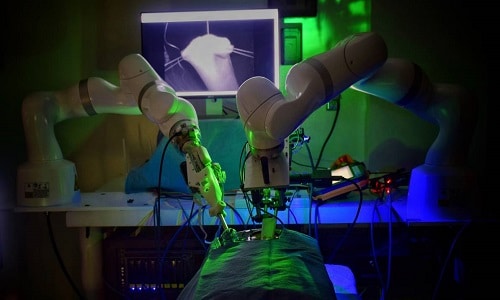Without any human help, the robot successfully performed a complex abdominal surgery, a significant achievement in medical progress

A few years ago, robotics in surgery had begun to be implemented on a large scale across hospitals around the world so that surgeons can be assisted in performing critical operations with precision. Advancements back then in artificial intelligence and machine learning made this possible. With further enhancements in microelectronics, image processing amongst others, these technologies have now evolved by leaps and bounds, providing even more precision.
A testament to the above statement is a research team from John Hopkins University who in collaboration with the Children’s National Hospital in Washington, D.C., has developed a fully automated robot that can perform surgery on humans without the support of doctors. This suggests that the day is not far away when doctors, who are prone to making errors and often undergo fatigue, can be helped by machines that can work non-stop with accuracy.
Known as Smart Tissue Autonomous Robot, or STAR, its testing was done on the soft tissue of a pig. The robot excelled at intestinal anastomosis, a medical procedure requiring a high level of repetitive motion and precision – without any human help. Since the medical process is highly challenging, any mistake on part of the surgeon arising from a hand tremor or misplaced stitch could lead to catastrophic complications in the patient
“Our findings show that we can automate one of the most intricate and delicate tasks in surgery: the reconnection of two ends of an intestine. The STAR performed the procedure in four animals and it produced significantly better results than humans performing the same procedure,” said Axel Krieger, assistant professor of mechanical engineering at Johns Hopkins’ Whiting School of Engineering.
Thanks to a novel control system along with a light-based 3D endoscope and machine learning-based tracking algorithm, the STAR can quickly adapt itself to any real-time unpredictabilities that arise in a medical procedure. Equipped with improved features for suturing and imaging systems, the STAR is an enhanced version of its predecessor that required a large incision to access the intestine and had less autonomy.
“What makes the STAR special is that it is the first robotic system to plan, adapt and execute a surgical plan in soft tissue with minimal human intervention,” said Hamed Saeidi, visiting research scientist of mechanical engineering at Johns Hopkins’ Whiting School of Engineering.
An increasing approach toward surgery using laparoscopes, which are small devices with a tiny video camera and light on the end calls for an efficient automated robotic system that can carry out operations with delicate handling.
“Robotic anastomosis is one way to ensure that surgical tasks that require high precision and repeatability can be performed with more accuracy and precision in every patient independent of surgeon skill,” Krieger said. “We hypothesise that this will result in a democratised surgical approach to patient care with more predictable and consistent patient outcomes.”






